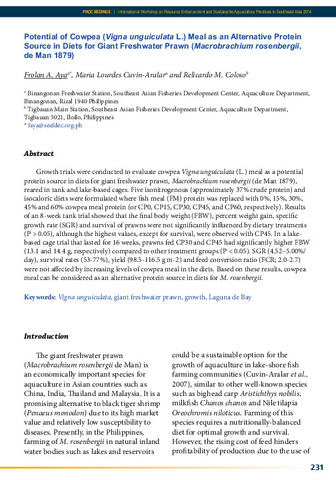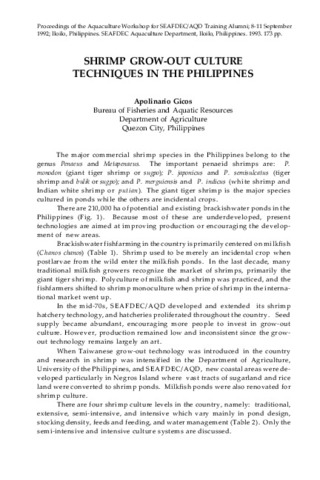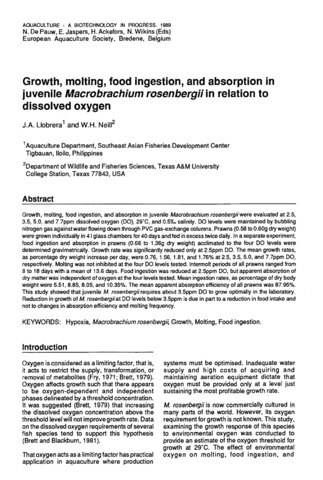Potential of cowpea (Vigna unguiculata L.) meal as an alternative protein source in diets for giant freshwater prawn (Macrobrachium rosenbergii, de Man 1879)
| dc.contributor.author | Aya, Frolan | |
| dc.contributor.author | Cuvin-Aralar, Maria Lourdes | |
| dc.contributor.author | Coloso, Relicardo M. | |
| dc.contributor.editor | Romana-Eguia, Maria Rowena R. | |
| dc.contributor.editor | Parado-Estepa, Fe D. | |
| dc.contributor.editor | Salayo, Nerissa D. | |
| dc.contributor.editor | Lebata-Ramos, Ma. Junemie Hazel | |
| dc.date.accessioned | 2016-01-20T07:39:19Z | |
| dc.date.available | 2016-01-20T07:39:19Z | |
| dc.date.issued | 2015 | |
| dc.identifier.citation | Aya, F. A., Cuvin-Aralar, M. L., &Coloso, R. M. (2015). Potential of cowpea (Vigna unguiculata L.) meal as an alternative protein source in diets for giant freshwater prawn (Macrobrachium rosenbergii, de Man 1879). In M. R. R. Romana-Eguia, F. D. Parado-Estepa, N. D. Salayo, &M. J. H. Lebata-Ramos (Eds.), Resource Enhancement and Sustainable Aquaculture Practices in Southeast Asia: Challenges in Responsible Production of Aquatic Species: Proceedings of the International Workshop on Resource Enhancement and Sustainable Aquaculture Practices in Southeast Asia 2014 (RESA) (pp. 231-237). Tigbauan, Iloilo, Philippines: Aquaculture Department, Southeast Asian Fisheries Development Center. | en |
| dc.identifier.isbn | 9789719931041 | |
| dc.identifier.uri | http://hdl.handle.net/10862/2778 | |
| dc.description.abstract | Growth trials were conducted to evaluate cowpea Vigna unguiculata (L.) meal as a potential protein source in diets for giant freshwater prawn, Macrobrachium rosenbergii (de Man 1879), reared in tank and lake-based cages. Five isonitrogenous (approximately 37% crude protein) and isocaloric diets were formulated where fish meal (FM) protein was replaced with 0%, 15%, 30%, 45% and 60% cowpea meal protein (or CP0, CP15, CP30, CP45, and CP60, respectively). Results of an 8-week tank trial showed that the final body weight (FBW), percent weight gain, specific growth rate (SGR) and survival of prawns were not significantly influenced by dietary treatments (P > 0.05), although the highest values, except for survival, were observed with CP45. In a lakebased cage trial that lasted for 16 weeks, prawns fed CP30 and CP45 had significantly higher FBW (13.1 and 14.4 g, respectively) compared to other treatment groups (P < 0.05). SGR (4.52 5.00%/ day), survival rates (53-77%), yield (98.5-116.5 g m-2) and feed conversion ratio (FCR; 2.0-2.7) were not affected by increasing levels of cowpea meal in the diets. Based on these results, cowpea meal can be considered as an alternative protein source in diets for M. rosenbergii. | en |
| dc.language.iso | en | en |
| dc.publisher | Aquaculture Department, Southeast Asian Fisheries Development Center | en |
| dc.subject | Vigna unguiculata | en |
| dc.subject | Macrobrachium rosenbergii | en |
| dc.subject | Giant freshwater prawn | en |
| dc.subject | Laguna de Bay | en |
| dc.title | Potential of cowpea (Vigna unguiculata L.) meal as an alternative protein source in diets for giant freshwater prawn (Macrobrachium rosenbergii, de Man 1879) | en |
| dc.type | Conference paper | en |
| dc.citation.spage | 231 | |
| dc.citation.epage | 237 | |
| dc.citation.conferenceTitle | Resource Enhancement and Sustainable Aquaculture Practices in Southeast Asia: Challenges in Responsible Production of Aquatic Species: Proceedings of the International Workshop on Resource Enhancement and Sustainable Aquaculture Practices in Southeast Asia 2014 (RESA) | en |
| dc.subject.asfa | growth rate | en |
| dc.subject.asfa | diet | en |
| dc.subject.asfa | weight | en |
| dc.subject.asfa | growth | en |
| dc.subject.asfa | feeds | en |
| dc.subject.asfa | cage culture | en |
| dc.subject.asfa | survival | en |
| dc.subject.asfa | proteins | en |
| dc.subject.asfa | prawn culture | en |
| dc.subject.asfa | feed efficiency | en |





